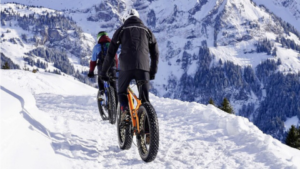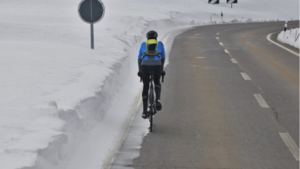In short, yes, you can ride a mountain bike in the snow. But with proper precautions, considering the slippery roads and ice. Mountain bikers have to do riding during wintertime. Most of them go biking with fat bikes. However, winter riding continued way before fat bikes were a thing.
Besides fat bikes, mountain bikes are made for serious off-road riding. Considering you are riding it on mountains, the area is rough and slippery during the winter. Here’s all you need to do before your next ride to the mountains.
Let’s get started.
Can You Ride on Snow With A Regular Mountain Bike?

You can ride on snow with a regular mountain bike. As said earlier, mountain bikes are more rigid than traditional bikes, so they can survive more adverse conditions.
Many mountain bikers use fat bikes during the winter, as it’s big and heavy-duty. But this doesn’t mean that you can’t have fun in the snow with your regular bicycle. It will be slightly more challenging than doing it on a fat bike.
Besides, who doesn’t love a challenge? It’s not the best way of snow riding, as you surely won’t be comfortable, but it does get the job done. The rest is up to you.
How To Prepare Before a Snow Ride?
Preparation for a snow ride will be different than your typical summer ride. Considering you’ll have to make adjustments, carry more, and be more careful. Here’s what you should do to prepare for a snow ride and be as minimal as possible.
Tracking your route
Understand that riding in the snow won’t equal riding in regular weather. The roads you’ve bossed around will be filled with snow, and the overall surface will be rough. This means you have to be extra careful.
Not just being careful, you will often have to change or cut short routes due to unavoidable circumstances. That said, make sure to track your path, as your route might not be the same as planned.
If you want to be extra careful, try taking a buddy with you or tell some friends beforehand about your ride. Snow rides are fun, but it’s also dangerous to do everything from scratch.
Gears
Adjust your gear and bike according to the weather. Your tire might need some adjustments. Your bike’s regular tire should be just fine, but if you go for a long day, you might switch up the tires a bit. We recommend getting tubeless, lightweight tires.
After you’re done with the bike, carry an extra bag with you. Or an emergency bag, blankets, a puffer jacket, or even a tent just in case it’s too dark to head back home. Take foil blankets instead of regular ones, as an average blanket might not be able to fight the cold entirely.
Take food some food and water with you, and it’ll be needed. Try to keep them as warm as possible; you will need more energy fuel than regular, considering riding in snow will consume more energy.
Apparel
This is a point that gets ignored often. People who think standard attire can save them in the snow are actual sufferers. Don’t underestimate how cold it might get.
We are trying to be as efficient as we can by carrying less. You can go full-sleeved jersey and tights as a base layer and work your way. Get a windproof or puffer jacket; these are the best options for cold.
Don’t forget a hand glove unless you don’t want to feel your hands after the ride. Regular gloves probably won’t cover the cold, so layering is the only way. Try wearing double layers wherever you feel cold. Feet and hands.
How to Ride in the Snow Avoiding Accidents?
The first and foremost thing you should understand before riding is that riding in snow will be far different from regular riding. It will be more challenging and time-consuming, but it’s all worth it.
Adjust your tire
Regular tires won’t be efficient during long rides. Fat tires are better; that’s why professionals switch to fat bikes during the winter. You don’t need to switch to a new bike for a few months if you make some readjustments.
Lower your tire’s psi, and the tire will adjust itself eventually. Don’t drop your air pressure to the point that you have to worry about a puncture; find the sweet spot.
Picking A Route
This is important, especially in the winter. As the roads will be rough regardless of what you do, the best way is to know how to tackle them.
Try to avoid the roads that are untouched, and you don’t know what’s in front. Rather ride through the roads where vehicles have passed through already. Go through roads that have solid snow and a road baseline.
Avoid slushy or icy roads as much as you can. They are the most prone places for accidents. Try riding through an open field rather than an isolated place. Riding in lofty mountains is challenging; doing it in a snow-filled area is dangerous.
Controlling your movements

Don’t make sudden movements. You have to fully control your bike and body to prevent injuries or accidents. Riding in the snow will require more precise and smooth movements. Causing sudden movements will make you prone to losing control and having an accident.
Avoid riding at either high or low speed; find a balance. Remember, momentum is the only thing that can save you during rides in the snow. Keep a constant speed, and move your upper body from side to side to take full advantage.
Watch out for icy roads
Icy roads won’t be in favor of you. So your best bet is avoiding them as much as possible because you don’t know when you will slip, even if you’re in complete control.
You also shouldn’t think that the surface you’re riding on right now will be the same when you go twenty meters forward; it’s very uncertain.
We recommend riding through trails you already rode through, as the area is familiar to you. Avoid deep snow as well.
Lower your Gears
Lastly, definitely have lower gear while riding in the snow. It would be best if you did not ride at high speed, especially in danger-prone zones. Mountain bikes have a low-range transfer case which offers the rider lower gear and a smoother, safer ride.
Lowered gear provides more control to the driver. You can always drop your gears manually if your bike doesn’t have a low-range transfer case. But make sure to have a steady pace rather than a fast pace during snow riding.
Conclusion
The answer to this is neutral. Riding in the snow is a lot of fun, but it does take some time in order to get used to it and master it. Snow riding is utterly different from summer riding, as there are more obstacles.
Nevertheless, snow riding is definitely not for everyone. It takes confidence and effort. You can ride in the snow on your mountain bike. Following the above tips can help you get the best enjoyment out of it.

I am Ryan Ford, a mountain biking enthusiast who loves to explore the outdoors. I also like to go on adventures with friends and anything else that involves being outside. I love my bike because it gets me out of the house and gives me an opportunity to enjoy nature.
